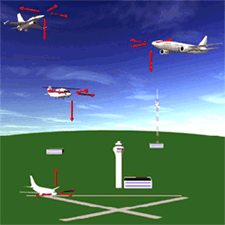ITT has been selected over Lockheed Martin and Raytheon to develop, deploy, own and operate the nationwide network of automatic dependent surveillance - broadcast (ADS-B) ground station that will be the backbone of the US Federal Aviation Administration's next-generation air transportation system.
The contract is valued at approximately $1.8 billion, with the system to be ready for use by 2010 and able to cover the entire USA by 2013. ITT will build, own and operate the ground stations and the FAA will pay subscription charges for ADS-B services to aircraft and air traffic control centres.

The FAA judged that ITT "offered an exceptional technical solution and superior cost-effectiveness with no evaluated technical risk", says John Kefaliotis, head of the company's proposal team. ITT proposed "a rigorously engineered flexible and scalable architecture that will effectively interoperate and not interfere with existing ATC equipment," he says.
The ADS-B ground stations will broadcast graphical weather, terrain maps and flight information and also provide surveillance services to ATC and aircraft.
Unlike Raytheon, which conversially proposed a system based only the 1090MHz datalink favoured by air transport, ITT's ground stations will adhere to the dual-link ADS-B solution selected by the FAA in 2002, Kefaliotis says, supporting both 1090 and the lower-cost 900MHz universal access transceiver (UAT) datalink preferred by general aviation.
The overall system will comprise radio sites and data processing and network operations centres. Thales North America will supply the 1090 and UAT radios and ITT will integrate the ground stations. Other members of the team include communications network provider AT&T and weather products provider WSI.
ITT's contract covers the FAA-funded development and testing of ADS-B at key sites: the Miami, Florida area for broadcast services; and Louisville, Kentucky, the Gulf of Mexico, Philadelphia and Juno, Alaska for surveillance services. The base contract also cover the roll-out of broadcast services on the East and West Coast and upper Midwest, says Kafaliotis.
Contract options cover the ITT-financed roll-out of the rest of the nationwide ADS-B infrastructure for broadcast and surveillance services.
Key-site testing of broadcast services is to begin in southern Florida early next year, aiming for a in-service date of November 2008. Testing of surveillance services is to begin at UPS's hub in Lousiville in March 2009, ready for service in 2010.
Source: FlightGlobal.com























